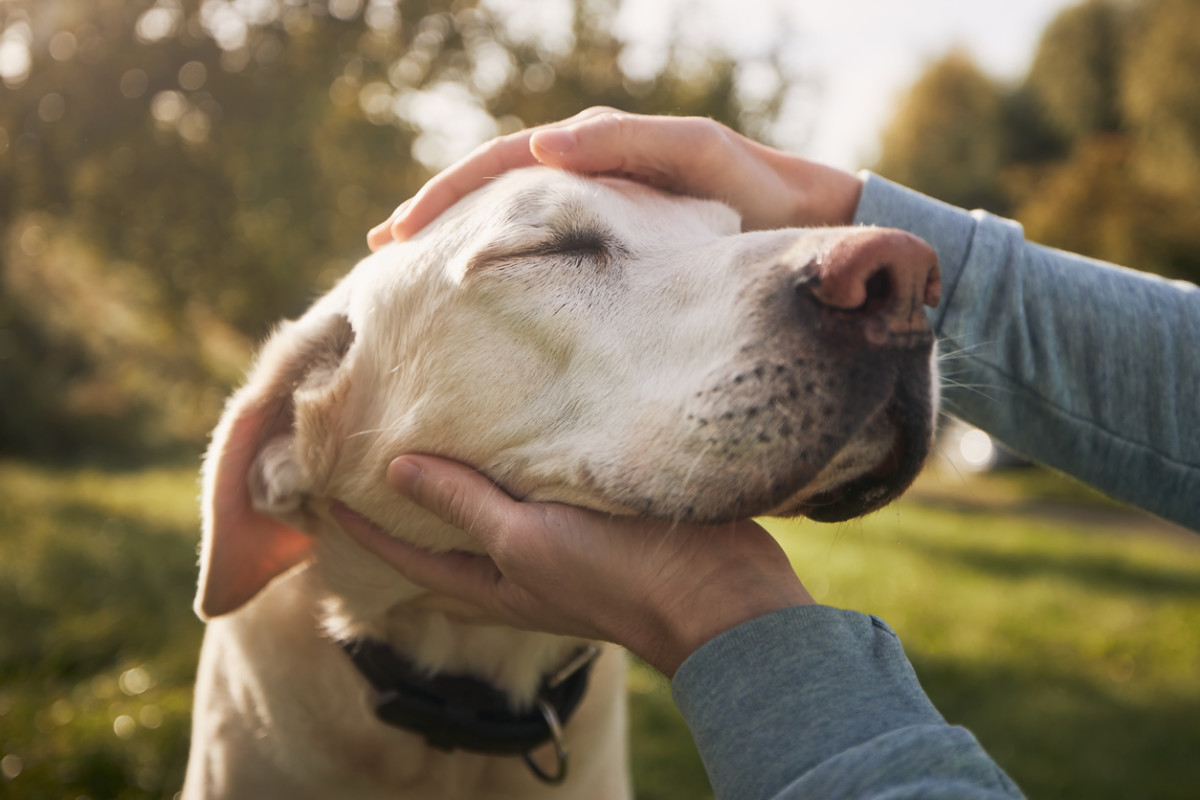Home>Health & Wellness>Behavior & Cognitive Care>How Long Is Too Long To Keep A Senior Dog In A Crate


Behavior & Cognitive Care
How Long Is Too Long To Keep A Senior Dog In A Crate
Modified: February 21, 2024
Learn about the appropriate duration for crating senior dogs and how it impacts their behavior and cognitive care. Find expert advice and tips.
(Many of the links in this article redirect to a specific reviewed product. Your purchase of these products through affiliate links helps to generate commission for Pawsomeoldies.com, at no extra cost. Learn more)
Table of Contents
Introduction
As our beloved canine companions age, their needs and care requirements evolve. Senior dogs, like their human counterparts, may experience physical and cognitive changes that necessitate adjustments in their daily routines and living environments. One common practice among dog owners is the use of crates, which can serve as a safe and secure space for dogs. However, when it comes to senior dogs, the question arises: How long is too long to keep a senior dog in a crate?
Understanding the unique needs of senior dogs is crucial for providing them with the best possible care and quality of life. While crating can be a valuable tool for training, safety, and management, it is essential to consider the potential risks and implications of confining a senior dog for extended periods. This article aims to explore the factors to consider when crating senior dogs, the potential risks associated with prolonged crate confinement, signs that may indicate a senior dog is spending too much time in a crate, alternative care options, and tips for safely crating a senior dog when necessary.
By delving into these aspects, dog owners and caregivers can gain valuable insights into promoting the well-being and comfort of their senior canine companions. It is important to approach this topic with empathy, understanding, and a commitment to providing the best care for senior dogs as they navigate the golden years of their lives.
Read more: Why Does My Senior Dog Keep Whining?
Understanding the needs of senior dogs
Senior dogs undergo a myriad of physical and cognitive changes as they age, necessitating a nuanced understanding of their evolving needs. Aging can bring about a decline in mobility, sensory perception, and cognitive function, making senior dogs more susceptible to discomfort and anxiety. Understanding these needs is crucial for providing appropriate care and ensuring their well-being.
-
Physical Comfort: Senior dogs often experience age-related conditions such as arthritis, joint pain, and muscle stiffness. As a result, they may require more frequent opportunities to stretch, move, and rest comfortably. Confinement in a crate for extended periods can exacerbate these physical discomforts, leading to decreased mobility and potential muscle atrophy.
-
Cognitive Stimulation: Aging can impact a dog's cognitive abilities, potentially leading to confusion, disorientation, and anxiety. Senior dogs benefit from mental stimulation and engagement to maintain cognitive function and emotional well-being. Prolonged crate confinement may contribute to feelings of isolation and distress, particularly for senior dogs experiencing cognitive changes.
-
Social Interaction: Senior dogs often crave companionship and reassurance. They thrive on social interaction and may experience heightened separation anxiety when isolated for prolonged periods. Understanding their need for companionship can guide caregivers in providing appropriate socialization opportunities and minimizing the negative impact of prolonged crate confinement.
-
Health Monitoring: Aging dogs may have specific health needs that require attentive monitoring and timely intervention. From medication schedules to bathroom breaks, senior dogs benefit from consistent monitoring and access to necessary resources. Crate confinement should be balanced with regular health checks and accommodations for their specific health requirements.
-
Comfortable Environment: Creating a comfortable and accessible living environment is essential for senior dogs. This includes providing soft bedding, easy access to water, and a suitable temperature to ensure their physical comfort and well-being. Prolonged crate confinement can limit their access to these essential elements, potentially compromising their overall comfort and health.
Understanding the unique needs of senior dogs is fundamental to tailoring their care and living arrangements. By recognizing the physical, cognitive, and emotional aspects of aging, caregivers can make informed decisions regarding the use of crates and ensure that the well-being of senior dogs remains a top priority.
The potential risks of keeping a senior dog in a crate for too long
Prolonged crate confinement for senior dogs can pose significant risks to their physical health, emotional well-being, and overall quality of life. While crates can offer a secure and controlled environment, excessive and extended confinement can lead to various adverse effects on senior dogs. It is essential for caregivers to be aware of these potential risks and take proactive measures to mitigate them.
Physical Health Implications
Extended periods of crate confinement can exacerbate age-related physical ailments in senior dogs. Conditions such as arthritis, joint stiffness, and muscle atrophy can worsen when a dog is unable to move freely and engage in regular physical activity. Prolonged confinement may lead to decreased muscle tone, reduced joint flexibility, and an overall decline in physical well-being. Additionally, the lack of movement can contribute to weight gain and obesity, further impacting a senior dog's mobility and overall health.
Emotional Distress and Anxiety
Senior dogs, particularly those experiencing cognitive changes, are susceptible to emotional distress when confined for extended periods. Feelings of isolation, anxiety, and restlessness can intensify, leading to behavioral issues and a decline in overall emotional well-being. Prolonged crate confinement may exacerbate separation anxiety, causing senior dogs to experience heightened stress and discomfort, ultimately impacting their mental health and quality of life.
Read more: Senior Dog Neutering Recovery: How Long
Reduced Social Interaction and Stimulation
Crates limit a senior dog's ability to interact with their environment and engage in social interactions, which are essential for their mental and emotional stimulation. Lack of socialization and environmental enrichment can lead to boredom, frustration, and a sense of confinement, negatively impacting a senior dog's overall well-being. The absence of mental stimulation and social engagement can contribute to cognitive decline and emotional disconnection, further compromising their quality of life.
Increased Risk of Accidents and Health Issues
Extended crate confinement can impede a senior dog's access to essential resources such as water, bathroom facilities, and comfortable resting areas. This limitation may increase the risk of accidents, dehydration, and discomfort, potentially leading to urinary tract issues, stress-related health problems, and a decline in overall health. Caregivers must consider the potential health implications of prolonged crate confinement and take proactive measures to minimize these risks.
Overall Impact on Quality of Life
The cumulative effect of the aforementioned risks can significantly impact a senior dog's overall quality of life. Prolonged crate confinement may lead to a diminished sense of comfort, security, and well-being, ultimately compromising their happiness and contentment. It is crucial for caregivers to prioritize the physical and emotional needs of senior dogs and make informed decisions regarding their living arrangements to ensure a high quality of life in their golden years.
Understanding the potential risks associated with prolonged crate confinement for senior dogs is paramount for making informed caregiving decisions. By recognizing these risks, caregivers can implement strategies to promote the well-being and comfort of their senior canine companions, ensuring that their needs are met with compassion and attentiveness.
Signs that a senior dog may be spending too much time in a crate
Recognizing the signs that indicate a senior dog may be spending excessive time in a crate is essential for caregivers to ensure the well-being and comfort of their canine companions. These signs serve as crucial indicators of potential distress, discomfort, or unmet needs, prompting caregivers to reevaluate their approach to crate confinement and make necessary adjustments to promote the senior dog's overall welfare.
-
Physical Discomfort: Senior dogs spending too much time in a crate may exhibit signs of physical discomfort, such as stiffness, reluctance to move, or difficulty standing up after being confined. They may also show signs of muscle atrophy or reduced muscle tone due to limited movement, indicating the detrimental impact of prolonged crate confinement on their physical well-being.
-
Restlessness and Pacing: Excessive crate confinement can lead to restlessness and pacing behaviors in senior dogs. When confined for extended periods, senior dogs may display repetitive pacing or circling movements, signaling their discomfort and the need for physical activity and mental stimulation.
-
Increased Vocalization: Senior dogs experiencing prolonged crate confinement may vocalize more frequently, expressing their distress, anxiety, or desire for social interaction. Excessive barking, whining, or howling can indicate their dissatisfaction with being confined and their need for companionship and environmental engagement.
-
Changes in Elimination Patterns: Senior dogs spending too much time in a crate may exhibit changes in their elimination patterns, such as increased accidents or reluctance to relieve themselves when given the opportunity. These changes can signal the negative impact of prolonged confinement on their bathroom habits and overall comfort.
-
Behavioral Changes: Prolonged crate confinement can lead to behavioral changes in senior dogs, including increased irritability, apathy, or withdrawal. They may display signs of depression, anxiety, or disinterest in activities they once enjoyed, reflecting the emotional toll of extended isolation and confinement.
-
Physical Ailments: Senior dogs confined for excessive periods may develop physical ailments such as pressure sores, stiffness, or joint discomfort due to prolonged immobility. These physical manifestations highlight the detrimental effects of prolonged crate confinement on their musculoskeletal health and overall physical comfort.
-
Reluctance to Enter the Crate: Senior dogs spending too much time in a crate may exhibit reluctance or resistance when being placed in the crate, signaling their aversion to prolonged confinement and their desire for alternative living arrangements that allow for more freedom and comfort.
Recognizing these signs empowers caregivers to assess the impact of crate confinement on their senior dogs and make informed decisions to prioritize their well-being. By remaining attentive to these indicators, caregivers can ensure that their senior canine companions receive the care and living arrangements that best support their physical, emotional, and cognitive needs.
Read more: How To Keep My Senior Dog From Being Bored
Alternatives to crating a senior dog for extended periods
When considering the well-being of senior dogs, it's essential to explore alternatives to prolonged crate confinement that prioritize their comfort, safety, and overall quality of life. Caregivers can implement various alternatives to ensure that senior dogs receive the necessary care and support without the prolonged use of crates.
Designated Dog-Friendly Areas
Creating designated dog-friendly areas within the home allows senior dogs to move freely and safely without the constraints of a crate. These areas can be equipped with comfortable bedding, access to water, and interactive toys to provide physical and mental stimulation while ensuring a secure environment.
Supervised Free Roaming
Supervised free roaming allows senior dogs to explore and move within a controlled space under the watchful eye of caregivers. This approach provides opportunities for physical activity, social interaction, and mental stimulation while minimizing the risks associated with unrestricted movement.
Comfortable Enclosed Playpens
Using comfortable enclosed playpens provides senior dogs with a secure and spacious area to move, play, and rest without the confinement of a traditional crate. Playpens can be customized to accommodate the specific needs and mobility limitations of senior dogs while offering a sense of freedom within a safe enclosure.
Read more: How To Help Dog With Crate Anxiety
Interactive Puzzle Toys and Enrichment Activities
Engaging senior dogs in interactive puzzle toys and enrichment activities can alleviate boredom and provide mental stimulation, reducing the need for prolonged crate confinement. These activities promote cognitive engagement and physical movement, contributing to the overall well-being of senior dogs.
Scheduled Outdoor Walks and Exercise
Incorporating scheduled outdoor walks and exercise sessions into a senior dog's routine allows for physical activity, sensory stimulation, and environmental exploration. Caregivers can tailor these activities to accommodate the mobility and energy levels of senior dogs, promoting their physical health and overall vitality.
Utilizing Pet Sitters or Dog Daycare Services
Engaging the services of pet sitters or enrolling senior dogs in dog daycare programs provides opportunities for socialization, companionship, and supervised care outside of a crate environment. These options offer a change of scenery and interaction with other dogs, contributing to the emotional well-being of senior dogs.
Adaptive Home Modifications
Making adaptive modifications to the home environment, such as installing ramps, providing orthopedic bedding, and creating easily accessible water and food stations, can enhance the comfort and mobility of senior dogs. These modifications support their independence and reduce the need for prolonged crate confinement.
By exploring these alternatives, caregivers can create a supportive and enriching environment for senior dogs, minimizing the reliance on prolonged crate confinement while prioritizing their physical, emotional, and cognitive needs. Each alternative can be tailored to accommodate the unique requirements of senior dogs, promoting their well-being and enhancing their quality of life.
Read more: When Is It Too Cold For A Dog With Arthritis
Tips for safely crating a senior dog when necessary
When the need for crate confinement arises for a senior dog, it is essential to approach the process with sensitivity and consideration for their well-being. Safely crating a senior dog involves implementing strategies that prioritize their comfort, safety, and overall welfare while ensuring that the crate serves as a supportive and secure space when necessary.
1. Proper Sizing and Comfort
Select a crate that provides ample space for the senior dog to stand, turn around, and lie down comfortably. The crate should be equipped with soft, supportive bedding to cushion their joints and provide a cozy resting area. Ensuring proper sizing and comfort within the crate is crucial for promoting the senior dog's physical well-being during confinement.
2. Gradual Acclimation
Introduce the senior dog to the crate gradually, associating it with positive experiences such as meals, treats, and interactive toys. This gradual acclimation helps create a positive association with the crate and reduces anxiety or resistance when it becomes necessary to confine the senior dog.
3. Short, Positive Encounters
When crating becomes necessary, keep the duration of confinement brief, especially initially. Use positive reinforcement and gentle encouragement to create a calm and reassuring environment within the crate. Short, positive encounters with the crate help alleviate stress and discomfort for the senior dog.
Read more: What Keeps Fleas And Mosquitoes Off Dogs
4. Consideration of Mobility
Take into account the senior dog's mobility limitations and any age-related conditions when crating. Ensure that the crate is easily accessible and does not require excessive physical effort for the senior dog to enter or exit. This consideration promotes their independence and reduces potential stress associated with crate confinement.
5. Monitoring and Supervision
When a senior dog is crated, maintain regular monitoring and supervision to ensure their comfort and well-being. This includes periodic checks for any signs of distress, discomfort, or the need for bathroom breaks. Monitoring and supervision are essential for addressing the senior dog's specific needs during crate confinement.
6. Environmental Comfort
Create a comfortable and calming environment around the crate, minimizing noise and disturbances that may cause anxiety for the senior dog. Providing familiar scents, soothing music, or a comforting blanket can contribute to the overall environmental comfort within the confined space.
7. Regular Breaks and Exercise
If feasible, incorporate regular breaks for the senior dog to stretch, move, and engage in light exercise outside of the crate. These breaks help prevent stiffness and promote circulation, contributing to their physical comfort and well-being during periods of confinement.
8. Consultation with a Veterinarian
Prior to crating a senior dog for extended periods, consult with a veterinarian to ensure that the confinement aligns with the dog's health needs and overall condition. Veterinarians can provide valuable guidance on safe crating practices tailored to the specific requirements of senior dogs.
By implementing these tips, caregivers can ensure that the process of crating a senior dog, when necessary, is approached with attentiveness and compassion. Safely crating a senior dog involves creating a supportive and comfortable environment within the crate, prioritizing their physical and emotional well-being while addressing their unique needs during periods of confinement.
Conclusion
In conclusion, the well-being and care of senior dogs require a thoughtful and considerate approach, especially when it comes to the use of crate confinement. Understanding the unique needs of senior dogs, the potential risks of prolonged crate confinement, and the signs indicating discomfort or distress are essential for caregivers to provide the best possible support for their aging canine companions.
While crates can serve as valuable tools for training, safety, and management, it is crucial to recognize that prolonged confinement can pose significant risks to the physical health, emotional well-being, and overall quality of life of senior dogs. The potential implications of extended crate confinement, including physical discomfort, emotional distress, reduced social interaction, and the overall impact on their well-being, underscore the importance of exploring alternative care options and implementing safe crating practices when necessary.
By considering alternatives to prolonged crate confinement, such as designated dog-friendly areas, supervised free roaming, comfortable enclosed playpens, interactive enrichment activities, and adaptive home modifications, caregivers can create supportive and enriching environments that prioritize the comfort and safety of senior dogs. These alternatives offer opportunities for physical activity, mental stimulation, social interaction, and companionship, contributing to the overall well-being and quality of life of senior dogs.
When crate confinement becomes necessary, implementing safe crating practices, such as proper sizing and comfort, gradual acclimation, short positive encounters, consideration of mobility, regular monitoring and supervision, environmental comfort, regular breaks and exercise, and consultation with a veterinarian, ensures that the senior dog's needs are met with compassion and attentiveness.
Ultimately, the well-being of senior dogs should remain a top priority, guiding caregivers to make informed decisions that promote their physical, emotional, and cognitive health. By approaching the care of senior dogs with empathy, understanding, and a commitment to providing the best possible support, caregivers can navigate the unique challenges of aging with their canine companions, ensuring that their senior dogs enjoy a comfortable, stimulating, and fulfilling life in their golden years.









